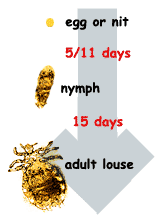Lice
How is a louse born and how does it live?
The life of a louse has three stages: egg or nit, nymph and adult. Lice live for between 30 and 40 days (If you don't get rid of them earlier!).

A female louse lays about 10 eggs a day, which means approximately 200 eggs in her lifetime.
Between 5 and 11 days after laying the eggs (maturation period), the nymphs appear. After three successive transformations, the nymphs in turn become adult lice within approximately 15 days.
The average life cycle of a louse lasts 18 days.
The warmth of the human body (37ºC) is very favorable for the development of lice. The adults feed on blood which they suck in very small amounts but very frequently. The saliva which the louse places in the small bite wound causes the irritation and itching.
Although lice are very small, they can be seen quite clearly. Even the nits or eggs, which are even smaller than adult lice (0.6-1 mm), can easily be seen. Sometimes they may look like dandruff, though unlike in the case of dandruff, if you shake or brush your hair the nits or eggs do not fall off. It is also possible to distinguish between full and empty eggs. The full eggs are white and do not shine, while the empty ones are almost transparent.
